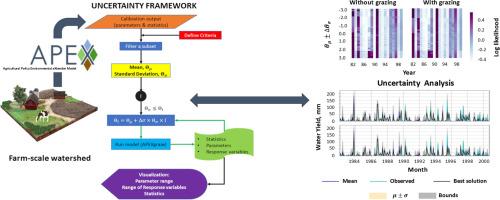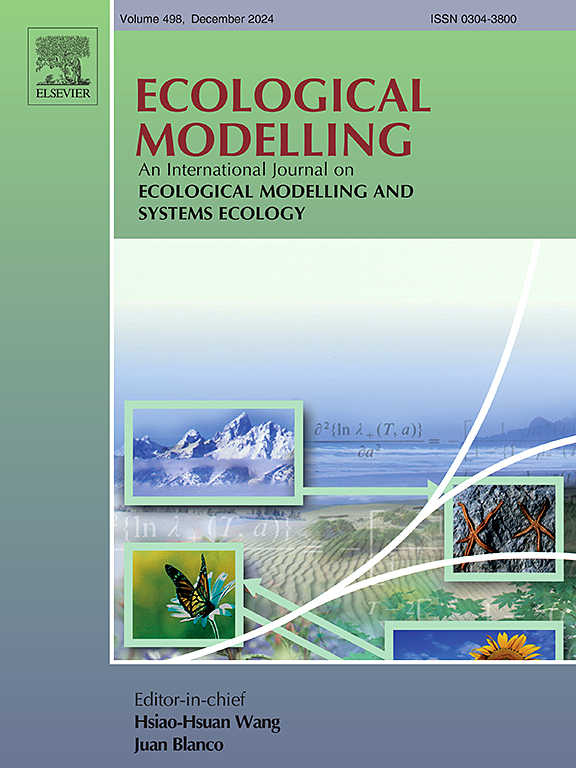Uncertainty analysis of hydrological parameters of the APEXgraze model for grazing activities
IF 2.6
3区 环境科学与生态学
Q2 ECOLOGY
引用次数: 0
Abstract
Researchers in hydrological sciences have developed agro-hydrological models to study water quantity and quality in small-scale watersheds. These models, however, often exhibit significant uncertainty in both parameters and response variables. The study aims to address limited research on the uncertainty range of runoff-related parameters in watershed models, particularly those analyzing the impact of grazing operations. It also seeks to improve existing uncertainty analysis protocols because these protocols rely on parameter distributions, which are often difficult to determine. A generalized uncertainty analysis protocol that statistically considers multiple acceptable solutions from calibrated agro-hydrological models was developed. This approach employed a variant of the Agricultural Policy eXtender (APEX) model with an expanded grazing module called APEXgraze to perform uncertainty analysis of runoff and sediment-related parameters. Four small-scale watershed models were developed for calibration: a) native prairie, b) native prairie under grazing operations, c) cereals (winter wheat and one season of oats), and d) the same cereals under grazing operations in a semi-arid region of Oklahoma, United States. This work demonstrated that a simplified uncertainty analysis approach effectively captured the internal dynamics of hydrological processes within a statistically significant range of parameters. This observation was evidenced by a small range of water balance in both magnitude and percentage. The procedure also helped identify redundant parameters in sensitivity and uncertainty analyses. The proposed generalized uncertainty analysis protocol offers a reliable method for assessing hydrological models' internal dynamics and identifying critical parameters. This approach can enhance the accuracy of watershed models, particularly in regions with grazing operations.

放牧活动 APEXgraze 模型水文参数的不确定性分析
水文科学研究人员开发了农业水文模型,用于研究小流域的水量和水质。然而,这些模型的参数和响应变量往往具有很大的不确定性。本研究旨在解决流域模型中径流相关参数不确定性范围研究有限的问题,特别是那些分析放牧影响的模型。研究还试图改进现有的不确定性分析规程,因为这些规程依赖于参数分布,而参数分布往往难以确定。我们开发了一种通用的不确定性分析方案,从统计学角度考虑了校准农业水文模型的多个可接受的解决方案。这种方法采用了农业政策 eXtender(APEX)模型的一个变体,该变体带有一个名为 APEXgraze 的扩展放牧模块,用于对径流和沉积物相关参数进行不确定性分析。为校准开发了四个小规模流域模型:a)原生草原;b)放牧条件下的原生草原;c)谷物(冬小麦和一季燕麦);d)美国俄克拉荷马州半干旱地区放牧条件下的相同谷物。这项研究表明,简化的不确定性分析方法能有效捕捉到参数统计范围内水文过程的内部动态。水量平衡的幅度和百分比范围都很小,就证明了这一点。该程序还有助于确定敏感性和不确定性分析中的冗余参数。所提出的通用不确定性分析规程为评估水文模型的内部动态和确定关键参数提供了一种可靠的方法。这种方法可以提高流域模型的准确性,尤其是在有放牧活动的地区。
本文章由计算机程序翻译,如有差异,请以英文原文为准。
求助全文
约1分钟内获得全文
求助全文
来源期刊

Ecological Modelling
环境科学-生态学
CiteScore
5.60
自引率
6.50%
发文量
259
审稿时长
69 days
期刊介绍:
The journal is concerned with the use of mathematical models and systems analysis for the description of ecological processes and for the sustainable management of resources. Human activity and well-being are dependent on and integrated with the functioning of ecosystems and the services they provide. We aim to understand these basic ecosystem functions using mathematical and conceptual modelling, systems analysis, thermodynamics, computer simulations, and ecological theory. This leads to a preference for process-based models embedded in theory with explicit causative agents as opposed to strictly statistical or correlative descriptions. These modelling methods can be applied to a wide spectrum of issues ranging from basic ecology to human ecology to socio-ecological systems. The journal welcomes research articles, short communications, review articles, letters to the editor, book reviews, and other communications. The journal also supports the activities of the [International Society of Ecological Modelling (ISEM)](http://www.isemna.org/).
 求助内容:
求助内容: 应助结果提醒方式:
应助结果提醒方式:


